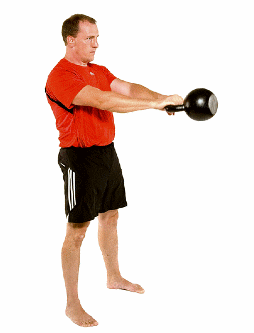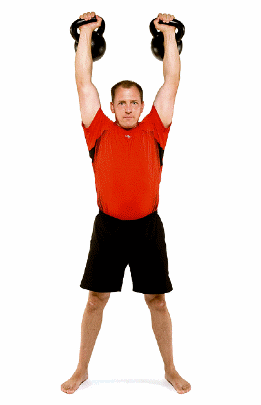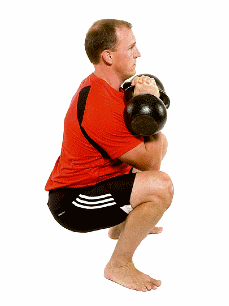A New Way to Look at Balance
Gray Cook, RKC
November 26, 2010 12:33 PM
Gray Cook, author of Movement: Functional Movement Systems,
with Brett Jones Co-presenters of the new DVD and manual set
Kettlebells from the Center—DynamiI wrote my first book,
Athletic Body in Balance, in response to what I witnessed in the first part of my career. As a sport and orthopedic physical therapist and a part-time strength coach, I was well-positioned to see all kinds of bodies doing all kinds of activities, and discovered all kinds of unexpected findings. In particular, I noted a lack of evenness when performing evaluations on athletes, patients and clients.
In using the word evenness, please understand this covers all of the following for both form and function—
- Upper body overdevelopment —lower body underdevelopment
- Lower body overdevelopment—upper body underdevelopment
- Significant limitation in some regions with little limitation in others
- Significant limitation in some movement patterns, but not in others
- Overdeveloped anterior muscles—underdeveloped posterior muscles
- Overdeveloped posterior muscles—underdeveloped anterior muscles
- Well-developed pushing movements—poorly developed pulling movements
- Well-developed pulling movements—poorly developed pushing movements
- Left- to right-sided asymmetries
Of these, the left-to-right asymmetries seem to be the most associated with risk of injury according to the evidence. As a matter of point the bulk of my lectures regarding movement screening and movement assessment revolve around discovery of asymmetries and motor control problems as risk factors for injury or re-injury.
Even though my professional work must stay close to the evidence and research, I still notice all the other elements, too. So let's discuss it.
The physical presentation of differently trained bodies often provides a signature of the type and style of activity that developed it. Those who are exclusive in their activities seem more often be molded to their activities, and sometimes actually over-molded. These individuals can actually lose movements and muscles that would make alternate activities much easier.
Some choose this path, and some are just victims. Specialization can rob us of our innate ability to express all of our movement potential. This is why I encourage highly specialized athletes to balance their functional movement patterns. They don't so much need to train all movement patterns, they just need to maintain them. When a functional movement pattern is lost, it forecasts a fundamental crack in a foundation designed to be balanced. The point is not that specialization is bad—it only presents a problem when the singular activity over-molds to the point of losing balance.
Some of the best strength coaches seem to concern themselves with balance of power. Their focus may not be on movement pattern balance, but at least they are concerned about balance. They identify more of a performance balance, a fundamental balance that can be seen by pushing and pulling abilities. This is intuitive, because our movement patterns grow out of opposing patterns. Physical therapy school described how the spiral and diagonal proprioceptive neuromuscular facilitation (PNF) patterns represented feeding patterns—diagonal patterns coming toward the head—and protection patterns—diagonal patterns going away from the head. It is easy to see how punching, throwing and swinging can grow out of these basic patterns.

The best strength coaches and trainers can also see how well-developed pushing and pulling patterns can create fertile soil to support more specialized patterns that incorporate a mix of both. I have always tried to categorized lifts into pushes, pulls and combinations for no other reason than to keep me out of the "single muscle lift" mindset. In a very basic way, pull movements and push movements incorporate the same muscles in different ways. The roles of the movers and stabilizers are often reversed. The best lifts always incorporate the entire muscular system, but we still tend to name them by the prime movers, the same way we complement a quarterback without mentioning the offensive line.
Balancing pushing and pulling strength can create a stable platform for power regardless of the sport of activity. My only caution is to get movement patterns acceptable first. This is my habit because as professionals we should not discuss exercise without a movement base or minimum level of movement-pattern capability. This means we don't assume that adding extra pushes and pulls will offer corrective benefit. These exercises should be considered conditioning exercises placed upon a fundamental base of acceptable movement patterns. In other words, own your movement screen minimums—a score of two on each test with no asymmetries. If this does not make sense yet, your next assignment is to read Movement: Functional Movement Systems.
Pushing and pulling on a good baseSome exercises incorporate a push in the lower body and a pull with the upper body. Take the straight bar clean, for instance, a great exercise with a moderate-to-high learning curve since most can't learn it in a day or a week. Compare this to a push press, where a lower body push complements an upper body push. The push press is much less complicated and can easily be learned in one session. It's actually just cheating your press, isn't it? We are born learning how to cheat, so why not use it?
When I suggest this option, I often meet resistance or skepticism, "We got to teach the clean because we need the power and quick leg action." Then we video just the legs for each lift and sure enough, if you can't see the upper body, you cannot tell which lift is being performed—the push press and the clean have nearly the same leg action. If we are doing the move to create power and quick leg action, why not pick the less complicated movement? Push presses can be performed with dumbbells, kettlebells and straight bars, just like cleans. The benefits can be equal and the learning curve is less (push on push), and the stress on the wrist is less, too. Safer and easier with equal benefits—no brainer!
Here is the cake recipe- Make sure squat mechanics are acceptable.
- Find the maximum stiff-knee press weight (one arm or two arm).
- Add a little weight and allow a little cheat up.
Here is the icing- By using a weight higher than the basic concentric press, you set up eccentric lowering.
- The eccentric work, if performed correctly, will create a stabilizing reaction in the shoulder and core, two places where it is often needed.
- Using a dumbbell or kettlebell will expose asymmetry. Look for it on the push move and on the lowering.

Push muscles incorporate prime drive from the anterior chain musculature, where pull movements incorporate prime drive in the posterior chain. Remember, however, not to get caught up on this. The drive side does create movement, but the non-drive side is the brakes. Good driving requires the gas and the brakes... used at the correct times. For some reason, though, pull movements are less popular at the corner gym. Maybe that's because the anterior chain musculature is easier to see in all those mirrors.
Either way, real strength enthusiasts know the power of having pull movement competency. Pullups and deadlifts are pulling fundamentals often overshadowed by bench work and squats. The kettlebell swing and snatch have become popular, but these are not new, and no one alive today invented them no matter what they say! They are old moves being both honored and dishonored depending on where the information originates. The primary drive for the pull movement in both the swing and the snatch are found in the deadlift. We often introduce the deadlift as a first gear to show its importance... a starting point. Try putting the swing and snatch on top of a good deadlift and see how much better things are. Present it like a manual transmission—
Gears- Deadlift
- Heavy deadlift—for most, this can be improving their
good-form original DL by 25-50%
- Swing
- Heavy swing—for most this can be improving their
good-form original swing by 25-50%
- Snatch

The kettlebell snatch is a flashy, fast and sexy overhead lift and most want to do it day one, right after they first see it. We must remember most of the muscles that put the kettlebell nicely overhead can be found below the waist in the posterior chain. Simply stated, if you own your deadlift and your swing, the kettlebell will float into place overhead when you learn to snatch.
A recipe for a great foundationTurning a good squat movement pattern into a lift and then turning a good squat lift into a push press can develop a great push foundation. Turning a good deadlift pattern into a lift and then turning a good deadlift into a swing can develop a great push foundation. Whether you are training a high school football team, working with clients or just trying to balance your push pull performance, this is a great starting point, and it is safe and simple.
Find your push- pull balanceMost of us will have a natural affinity toward pushing or pulling—one will just feel more natural. The reasons are never singular; body dimensions, angles and limb length are at the beginning of the discussion. Posture, muscle orientation, activity history and injury history also play a role. Pay particular attention to breathing between pushing and pulling movements. Note how the movements that look and feel good will have a particular breathing pattern. Also note how proper breathing and pressurization can improve the ones that seem awkward and disconnected.
 Putting it all together
Putting it all togetherRecently, Brett Jones and I returned to the Old Gym at Averett University to try to regain a little old-school wisdom. We initially shot
Kettlebells from the Ground Up and
Club Swinging Essentials at this same location. Our third installment on this old-school theme is
Dynami, the Greek word for power. In it, we discuss balancing pushing and pulling form, adding strength to that form, and then adding power to that strength. Hopefully you will learn from the project just as we did. Done correctly less can be more!
Please visit graycook.com and appliedstrength.blogspot.com for more from Gray Cook and Brett Jones. For more information on movement screening, assessments, certification and registry, go to functionalmovement.com.
Back